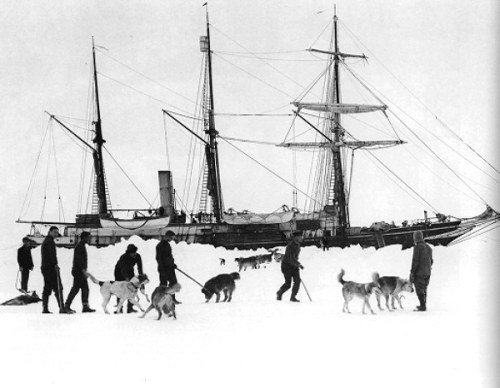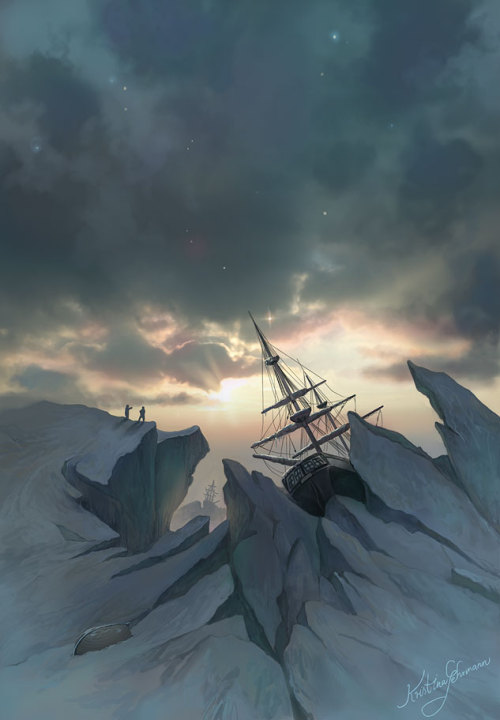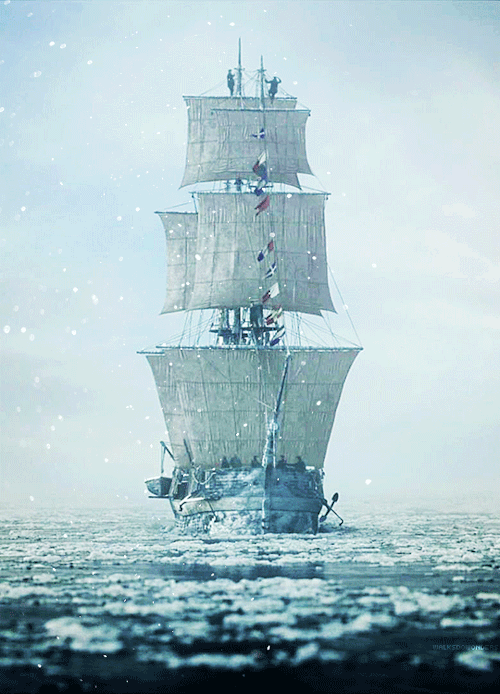Latest Posts by flurries-and-frost - Page 5

Endurance

Scott’s ship the “Terra Nova” moving through the pack ice. Notice the funnel. The ship had a steam engine, of course.

Beaufort Island and Mount Erebus. Discovered 28 Jan 1841, John Edward Davies, 1841 - Captain James Clark Ross, Antarctic Expedition
Frank Hurley :: Sclater penguin, from [Exhibition of pictures taken during the Australasian Antarctic Expedition and other photographic studies], 1911-1914 / src: State Library of New South Wales
more [+] by this photographer

Taking pictures of penguins during the First Soviet Antarctic Expedition (1955)

In temperatures that drop below -20 degrees Fahrenheit, along a route occasionally blocked by wind-driven ice dunes, a hundred miles from any other people, a team led by two of our scientists are surveying an unexplored stretch of Antarctic ice.
They’ve packed extreme cold-weather gear and scientific instruments onto sleds pulled by two tank-like snow machines called PistenBullys, and after a stop at the South Pole Station (seen in this image), they began a two- to three-week traverse.
The 470-mile expedition in one of the most barren landscapes on Earth will ultimately provide the best assessment of the accuracy of data collected from space by the Ice Cloud and land Elevation Satellite-2 (ICESat-2), set to launch in 2018.
This traverse provides an extremely challenging way to assess the accuracy of the data. ICESat-2’s datasets are going to tell us incredible things about how Earth’s ice is changing, and what that means for things like sea level rise.
Make sure to follow us on Tumblr for your regular dose of space: http://nasa.tumblr.com.

The barque Europa on her way to the Antarctic








.
‘the seafarer’ (anglo-saxon poem, 8th cent.)
the shipwreck (j.m.w. turner, 1805)
‘the explorer’ (rudyard kipling, 1898)
man proposes, god disposes (edwin henry landseer, 1864)
“the lost city of z”, the new yorker (david grann, 2005)
last photo of george mallory and andrew irvine before their fatal ascent of mt. everest. it is still unknown if they reached the summit. (1924)
john keats (personal letter to j.h. reynolds, April 1817)

Man Proposes, God Disposes (1864) by Edwin Henry Landseer










The Endurance



On this day, 5th January 1922, Ernest Shackleton, died.
Sir Ernest Shackleton was an Antarctic explorer, best known for leading the ’Endurance’ expedition of 1914-16.
Ernest Henry Shackleton was born on 15 February 1874 in Ireland but his family moved to London where Shackleton was educated. He joined the merchant navy when he was 16 and qualified as a master mariner in 1898.
In 1901, Shackleton was chosen to go on the Antarctic expedition led by British naval officer Robert Falcon Scott on the ship ‘Discovery’. The team trekked towards the South Pole in extremely difficult conditions, getting closer to the Pole than anyone had come before. Shackleton became seriously ill and had to return home.
In 1908, he returned to the Antarctic as the leader of his own expedition, on the ship 'Nimrod’. During the expedition, his team climbed Mount Erebus, made many important scientific discoveries and set a record by coming even closer to the South Pole than before. Shackleton was knighted on his return to Britain.
In 1911, Norwegian explorer Roald Amundsen reached the South Pole, followed by Scott who died on the return journey. In 1914, Shackleton made his third trip to the Antarctic with the ship 'Endurance’, planning to cross Antarctica via the South Pole. Early in 1915, ’Endurance’ became trapped in the ice, and ten months later sank. Shackleton’s crew had already abandoned the ship to live on the floating ice. In April 1916, they set off in three small boats, eventually reaching Elephant Island. Taking five crew members, Shackleton went to find help. In a small boat, the six men spent 16 days crossing 1,300 km of ocean to reach South Georgia and then trekked across the island to a whaling station. The remaining men from the 'Endurance’ were rescued in August 1916. Not one member of the expedition died. Shackleton’s account of the 'Endurance’ expedition, South was published in 1919. The State Library of New South Wales holds a number of editions of this book, including first editions.
Shackleton’s fourth expedition aimed to circumnavigate the Antarctic continent but on 5 January 1922, Shackleton died of a heart attack off South Georgia and he was buried on the island.
The State Library of New South Wales holds collections of photographs depicting Shackleton’s expeditions, including these taken by photographer Frank Hurley. Photographs of Sir Ernest Shackleton’s trans-Antarctic expedition in the 'Endurance’, ca. 1914-1917
My quirky and curious Adélie penguin friends
“a grand nautical drama”

On their illustrious 1841 return from a successful first season in the Antarctic which marked Ross’ discovery of his eponymous 200 foot tall ice shelf (among other finds including an impressive amount of dead bird specimens) Captains Crozier and Ross were treated to a well-meaning, but by all accounts tooth-pullingly painful theatrical production by Hobart’s enthusiastic dramatic society.
Both Crozier and Ross politely (and wisely) declined to appear. Eleanor Franklin, daughter of Sir John, was not allowed to attend as her father “did not approve of the theatre,” but heard enough to recount to a friend that the most unbelievable exaggeration was that “Sir John had hair!”
It was so bad that surgeon Robert McCormick who had chosen to make an appearance and no doubt regretted it, gratefully concealed himself in a curtained box seat until it was over.
The Grand Ball hosted on Erebus and Terror–gorgeously bedecked in mirrors, steel bayonet chandeliers, with Erebus’ deck cleared as a dance floor and Terror groaning to the gunwales with food, claret, champagne, and port–no doubt made up for it. 300 guests and both captains danced until six in the morning. The Hobart Town Advertiser gushed that it was ‘quite impossible for any fete to have been more elegant and tasteful.” It became known throughout Hobart as “The Glorious First of June.”
The next day they “cleaned up the Wreck” with the worst hangovers of their lives.



Erebus and Terror in the Antarctic. The ships almost never made it to the arctic. In 1842, three years before sailing into the northwest passage, the ships collided with each other at the opposite end of the earth. James Clark Ross, then at the helm of Erebus, turned sharp to avoid a massive iceberg. Crozier, commanding Terror, was unable to avoid smashing into Erebus. The collision jolted the crew, and the two ships’ rigging became entangled for what must have been a harrowing incident until Terror was able to break free. Form what I’ve read, Crozier recalled that he merely acted and didn’t quite remember what he did to break free.










The men (and dogs) of the First Australasian Antarctic Expedition, 1911-1914. Images from the State Library of New South Wales; photographs by the inimitable Frank Hurley (and a few by other expedition members).
Bonus: expedition leader Douglas Mawson balancing on the rail of the Aurora with a delightfully boyish grin.


The French Astrolabe and the Zelee caught in Antarctic ice 1838 during the Expedition of Jules Dumont d'Urville, watercolour by A. Mayer 1838

Walking in the Pack, Ross Expedition, by John Edward Davis 1842 ( Captain John Edward Davis (1815-1877) was 2nd Master of the Terror during Ross’ Antarctic expedition)

HMS Erebus in the Antarctic, detail of a painting by John Willson Carmichael, 1847 - edit by Canada History

Examples of Inuit clothing. The ironic problem of wearing linen and cotton clothing in the arctic was sweat. Activities such as manhauling, warping the ship, and preparing camp were strenuous, and the men would sweat from the exertion. The problem came when they stopped. In low arctic and Antarctic temperatures the sweat would freeze almost instantly, leaving the unfortunate individual wearing what was more or less a sheet of ice.This, of course, ended in frostbite and hypothermia. Several explorers accounts recall clothing and sleeping bags that were like sheets of iron, thawed only with more exertion. The Inuit not only relied on dogs for hauling thus saving unnecessary exertion, they also overcame that tropical adaptation to cooling off all humans have with their clothing. Hides do not absorb sweat as readily, and were softened by chewing. Anoraks also are designed to ventilate, as discovered and described by Amundsen when he began wearing Netchili clothing. The air running through it evaporates the sweat and ends up leaving the wearer virtually free of ice garments.

“The ice was here, the ice was there, The ice was all around.” (S. T. Coleridge)
A digital painting based on a 19th century engraving.
Print available on Inprnt

